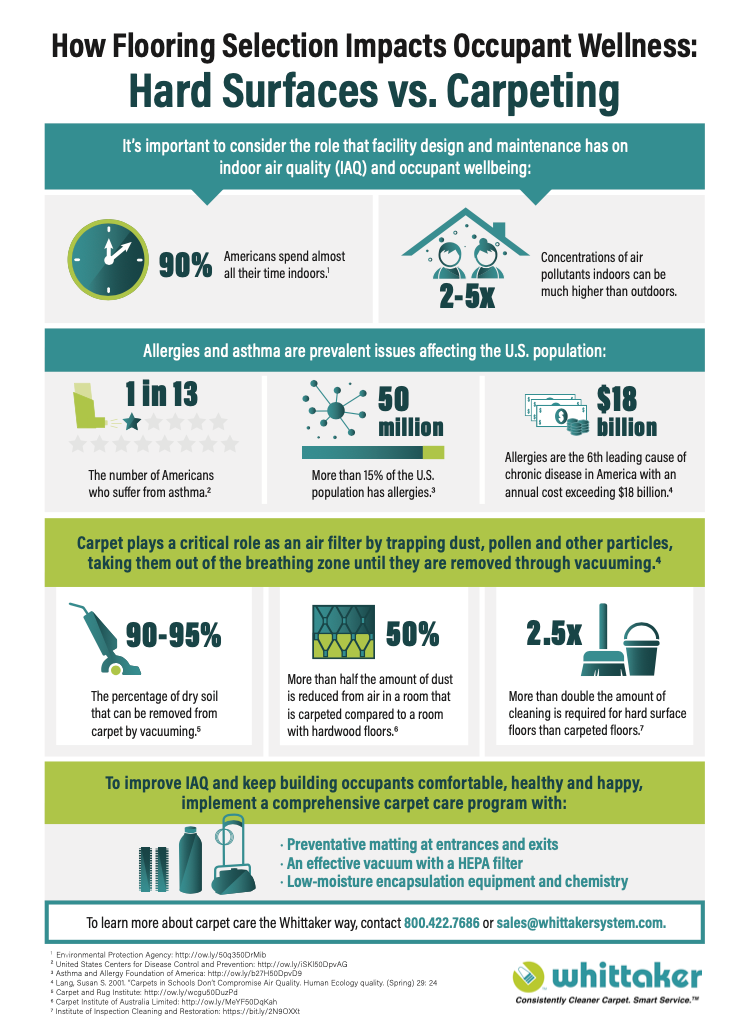There are many factors for facility managers and other leaders to consider when installing new flooring in an environment like a school, hotel or long-term care facility. These include lifespan, environmental impact, construction and durability, appearance and stain resistance, maintenance requirements, acoustics, material and installation costs and more. Hard flooring like wood, vinyl or tile will certainly provide a different experience than a softer surface like carpet tiles or broadloom carpet.
Another important consideration is the potential impact that healthcare flooring materials will have on the wellbeing of those who live, work and visit the facility. Read on to learn more about the differences between hard surface flooring and soft surfaces like carpet to determine which is right for your facility.
How Healthcare Flooring Options Affect Asthma and Allergies
Unfortunately, many suffer from chronic illnesses that can be further exacerbated by indoor air quality (IAQ). Flooring and the way in which it is maintained impacts IAQ.
According to the United States Centers for Disease Control and Prevention (CDC), 1 in 13 people have asthma. Another troubling fact is that asthma is being diagnosed at a growing rate for that last 40 years in all age, sex and racial groups. Asthma can cause unpleasant symptoms, episodes and even death.
Allergies are another recurring concern for many people. More than 50 million Americans have allergies, which result in annual costs exceeding $18 billion. Indoor air can aggravate allergy symptoms.
Research shows that carpet is actually better at controlling allergens compared to hard surfaces. A 15-year study in Sweden found no evidence linking carpet with allergy or asthma, and a 70% decrease in carpet usage led to a 30% increase in allergy reactions in the country. Additionally, according to the Carpet Institute of Australia Limited, carpet reduces dust in the air nearly 50% better than that of hardwood floors.
If hard surface flooring is not consistently cleaned, movement caused by walking can kick up dust that impacts asthma and allergy sufferers. Plus, hard flooring can be more expensive to maintain. Thus, the rise in luxury vinyl flooring deserves careful consideration.
Maintaining Soft Surfaces
Proper carpet care is essential for reducing long-term maintenance and replacement costs, limiting unnecessary landfill waste and preserving the color, luster and cleanliness of carpet. Some facilities conduct maintenance every day due to high foot traffic while others opt to follow a less frequent but dedicated schedule.
Whichever frequency you adopt, consider the following best practices to help your cleaning program meet its goals.
- Vacuum regularly – Regular vacuuming, in some cases daily, helps remove soils like dirt, salt and sand from carpet, as well as fur, dander and other allergens. In fact, vacuuming, rather than using a broom that may kick up dust, is often recommended for those with allergies. Consult the Carpet and Rug Institute for a list of recommended machines that adequately remove soils and uphold good IAQ.
- Clean on a deeper level – In addition to vacuuming, interim maintenance that targets embedded and older soils is key. Low-moisture encapsulation is one method that enables cleaning professionals to conduct thorough carpet care between vacuuming and more intensive and infrequent processes like hot water extraction. Encapsulation targets surface soils as well as materials that have fallen deeper into carpet fibers and may have been missed by vacuuming.
- Avoid indoor air pollutants – Cleaning carpet frequently and properly is one proven way to improve IAQ. Another is to avoid using cleaning products that work against the efforts you’ve put into managing air quality. Avoid carpet and surface cleaners that use volatile organic compounds and instead search for certified Green Seal® solutions that meet sustainability and health and safety standards.
These simple steps will go a long way in supporting IAQ, flooring assets and the people who use these facilities. Remember to set a cleaning schedule that properly addresses your environment’s soil loads, foot traffic patterns and flooring types.
Why Careful Healthcare Flooring Selection is Key
While floors affect the way indoor spaces look, there is much more to this design and architectural element. Flooring for healthcare environments and the maintenance approach used within a facility can also impact the health and safety of occupants and visitors.
While many people unfairly assume that carpet is the source of contaminants that aggravate conditions like asthma and allergies, there is evidence to support the fact that carpet is a safe flooring choice and that hard flooring doesn’t necessarily equate to better health. Thus, vetting each option without bias is key for selecting the type of flooring that is best suited to the facility’s needs and the people who use these spaces.
Carpet offers many advantages, and so does proper maintenance. Whittaker’s machines are used by facilities and service providers of all sizes.


